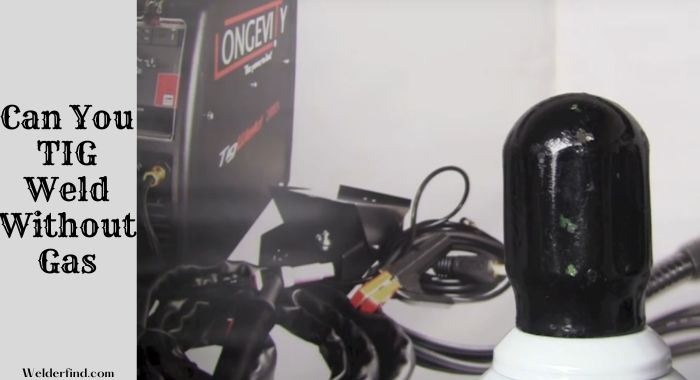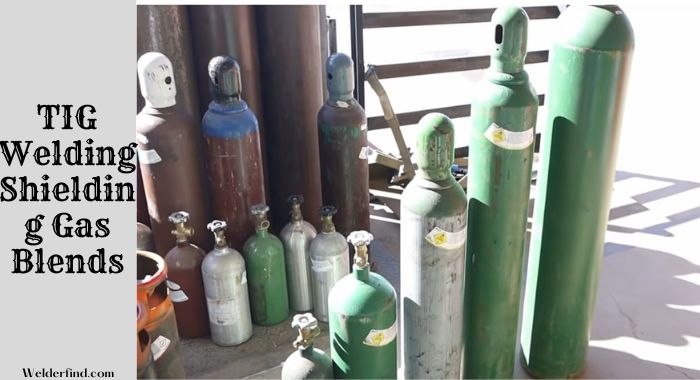TIG welding, or the Tungsten Inert Gas welding process, uses gas to ensure strength and durability. This welding process uses a mixture of non-consumable tungsten electrodes and shielding gas.
You will also need skills, practice, and precision to perform intricate TIG welding tasks.
Can You TIG Weld Without Gas?

You cannot TIG weld without using gas. You will need inert gas to shield the weld from the environment and prevent oxidation while welding. Several inert gases are used for TIG welding, such as argon, helium, argon-helium mixture, etc. But argon is the most used gas among them.
In the welding process, gas passes through the welding torch and creates a protective bubble around the weld. If you do not use gas, the weld will become oxidized, and you won’t be able to make it solid or crack-resistant.
What is the Purpose of Gas in TIG Welding?
Gas is an essential element in TIG welding. People use it in the TIG welding process to make a protective layer of inert gas between the item you are welding on and the welding arc.
The gas works as a protective layer for the weld and safeguards it from contaminants in the air, like oxygen. These contaminants can make your weld weak and crack-prone.
A gas also helps the weld penetrate well by creating a stable arc. Plus, it also reduces spatter and heat during the welding process.
TIG Welding Shielding Gas Blends

Argon and helium are the most commonly used gases for TIG welding. However, different blends of shielding gas are used for the process. Let’s see some of the blends.
Helium + Argon
Helium and argon shielding gas blend is very commonly used in TIG welding. While argon stabilizes the arc and protects it from oxidation, helium enhances the heat and makes it penetrate the weld well.
Using this gas blend, you can also increase the speed of your welding process and improve its bead appearance.
The helium and argon blend is ideal for stainless steel and aluminum welding and various ferrous and non-ferrous alloys.
95% Argon + 5% Hydrogen
A mix of argon and hydrogen with 95% argon and 5% hydrogen will provide a stable arc and create better control over the welding puddle.
With a higher removal of pure argon, this gas blend is a good option for thick welding parts.
You can also use it for multi-pass welding applications. The mix is mainly used to weld on metals like stainless steel, titanium, copper, copper alloy, etc.
98% Argon + 2% Nitrogen
A shielding gas blend with 98% argon and 2% nitrogen is a popular choice for TIG welding. The mix provides an excellent balance between cleaning action and arc stability.
The 2% nitrogen in the mix prevents weld porosity and helps penetrate well in thicker materials. That’s why this gas blend is used in various welding applications.
Choosing The Best TIG Shielding Gas For The Right Job
You already know that gas is a must for TIG welding. But different gas and gas mixture works better with different metals. So, choosing the suitable shielding gas for the right job is imperative.
Let’s see which gases will better suit different metals and welding jobs.
Welded Metal
The best TIG shielding gas for welded metal is a mixture of argon and helium. It provides great stability, excellent penetration, and overall weld quality. Plus, it will also provide a higher temperature for an increased welding speed.
Using less helium in the mix can cause less penetration. You can use a 50-50 mixture of helium and argon. Argon will provide a higher welding speed and better cleaning, while helium will help penetrate well and increase the bead width.
Mild Steel
You should use a mix of argon and carbon dioxide for mild steel welding as a shielding gas. This mixture will give you an excellent finish with a smooth weld. Plus, this gas mixture will protect your workpiece while welding.
You can use 90% argon and 10% carbon dioxide in the mixture. It is the most commonly used Argon-CO2 mixture. But if your mild steel is thicker, you can use 15 to 20 percent carbon dioxide for better penetration.
Stainless Steel
You can use two types of gas mixtures with stainless steel. Both argon helium and argon hydrogen mixtures will provide excellent puddle control and penetration during the welding process. The argon helium mixture should be 50-50 or 75-25.
It will provide higher welding speed and low gas flow, which is a requirement for welding stainless steel.
You can also use an argon hydrogen mixture where carbon will be 95 to 98 percent, and hydrogen will be 2 to 5 percent.
Aluminum
The best shielding gas mixture for welding anodized aluminum is argon helium gas. It provides an excellent welding arc start and cleaning action. A 75-25 mixture of argon helium will provide a very high welding speed and moderate penetration.
On the other hand, a 50-50 mixture will provide deep welding penetration and a very high speed. So, use a mixture based on your requirement.
Exotic Metals
You will have to choose the best gas for TIG welding exotic metals based on their thickness. You will need smaller welding arcs for thin metals, and thick metals will need larger welding arcs.
Generally, pure argon is considered the best shielding gas for TIG welding exotic metals. But you can also use the argon-helium mixture as 75-25 or 50-50.
Final Thoughts
You cannot TIG weld without using gas. In fact, gas is one of the main components in the tungsten inert gas welding process.
So, now that you know which gas or gas mixture is best for which metal, you can confidently perform TIG welding projects.
FAQs
Can I TIG weld steel with 100% argon?
Yes, you can sue 100% argon in the TIG welding process. Argon is the most commonly used and economically suitable inert gas for preventing oxidation with a cleaner weld.
Can I use oxygen for TIG welding?
You should not use oxygen in the TIG welding process. Oxygen reacts with the heat generated by the metal while welding and creates oxidation. It makes the weld weaker and bad-looking.
